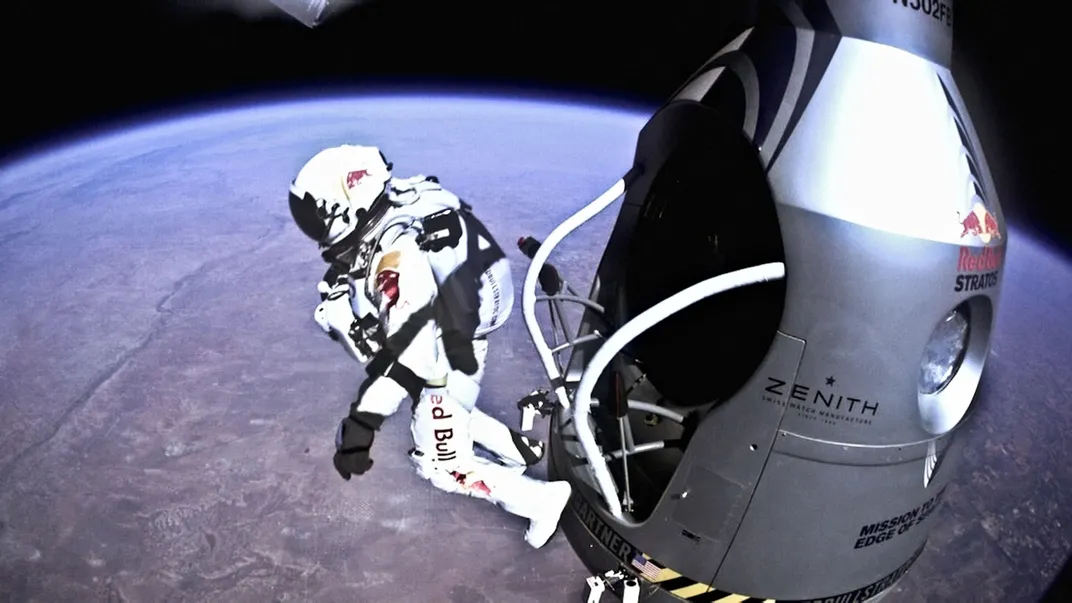Felix Baumgartner’s “Edge of Space” Capsule Goes on Display
Items from the Austrian daredevil’s record-setting jump enter the Museum’s collections.
/https://tf-cmsv2-smithsonianmag-media.s3.amazonaws.com/filer/e7/51/e7519cba-2181-48bd-bab2-d4d144f16cf2/16a_jj14_nasm2014-01460_live.jpg)
On the morning of October 14, 2012, Austrian parachutist Felix Baumgartner stepped from a balloon gondola more than 24 miles above Roswell, New Mexico. Just over nine minutes later, he was safely back on the ground, having set three world records: highest balloon flight, highest free fall, and greatest speed in free fall (843 mph). With the world watching on live television, Baumgartner became the first human to break the speed of sound in free fall.
The balloon gondola from which Baumgartner made his record-setting jump, and the pressure suit and parachute that he wore during a preliminary jump (from 95,040 feet on July 25, 2012) went on display in the National Air and Space Museum on the National Mall on April 2, 2014 in a temporary exhibition called “Red Bull Stratos: Mission to the Edge of Space.”
The balloon that carried him to the roof of the sky was constructed of polyethylene film, 0.0008 inch thick, not unlike a dry cleaning bag. Polyester fiber load-bearing tapes carried the 2,900-pound weight—close to that of a Volkswagen Beetle—of the pressurized gondola and pilot. At launch, the envelope, which contained almost 30 million cubic feet of helium, stood 55 stories tall. Designed and built by the David Clark Company, Baumgartner’s pressure suit was based on similar garments worn by high-altitude reconnaissance pilots. In addition to his main parachute, a 270-square-foot ram air model, Baumgartner was outfitted with both drogue and reserve chutes, just in case.

“The exit was perfect, but then I started spinning slowly,” Baumgartner says. “I thought I’d just spin a few times and that would be that, but then I started to speed up. It was really brutal at times. I thought for a few seconds that I’d lose consciousness. I didn’t [hear] a sonic boom because I was so busy just trying to stabilize myself.” He succeeded in stabilizing himself without having to deploy his drogue chute. “It was really a lot harder than I thought it was going to be.”
In addition to establishing Baumgartner in the record books, the project made important contributions to aerospace safety. Achievements included the development of a new generation of spacesuits and parachute systems, the establishment of protocols for exposure to the extreme conditions of pressure and temperature, and the study of the impact of supersonic acceleration and deceleration on the human body. “We’ll be setting new standards for aviation,” reported Jonathan Clark, the Red Bull Stratos medical director, who had served as crew surgeon for six space shuttle missions. “Never before has anyone reached the speed of sound without being in an aircraft,” he noted. “Red Bull Stratos is testing new equipment and developing the procedures for inhabiting such high altitudes as well as enduring such extreme acceleration. The aim is to improve the safety for space professionals as well as potential space tourists.”
The Museum is the final stop on a five-city tour for the exhibition. The display recounts the details of the Stratos project and the work of the support team, headed by Art Thompson, the designer of the capsule and technical manager of the effort. Joe Kittinger, the legendary airman who had held the record with a jump from 102,800 feet in 1960, was responsible for flight operations and safety. In addition to the historic hardware, the exhibit includes audio-visual and interactive elements inviting visitors to share some of the excitement of this extraordinary event.
Following the close of the temporary exhibition on June 26, the capsule, and pressure suit and parachute that protected Baumgartner during his descent back to Earth in October will be put on permanent display at the Museum’s Steven F. Udvar-Hazy Center.